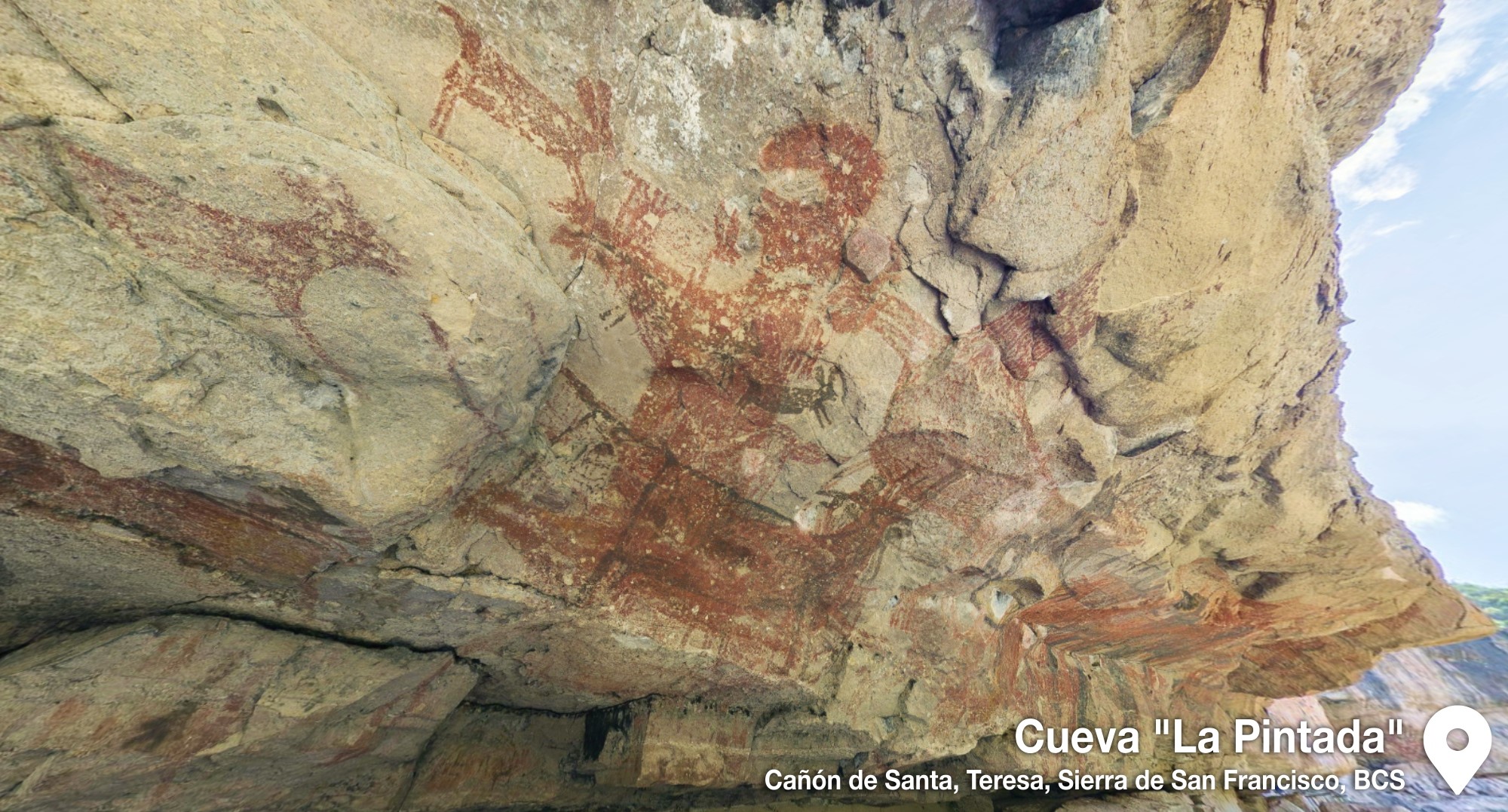CUEVA LA PINTADA
Mulegé, Mulegé

La cueva Pintada se localiza al margen derecho del arroyo de San Pablo, en la profundidad de un cañón llamado Santa Teresa, o también “Salsipuedes”. La cueva está a una altitud de quinientos cuarenta metros, en pleno corazón de la sierra de San Francisco, municipio de Mulegé, en México. El nombre de “La Pintada” se debe a los primeros rancheros que vivieron en sus cercanías pues, así la mencionaran debido a la gran cantidad de figuras, líneas y puntos que de manera profusa fueron ahí realizados. Muchas de las figuras están pintadas encima de otras formando hasta siete capas pictóricas distintas, al grado que es difícil reconocer unas de otras, particularmente las más profundas. Durante algún tiempo La Pintada fue conocida con el nombre de “Cueva Gardner” debido a que el escritor norteamericano Erle Stanley Gardner las dio a conocer mediante un reportaje que se publicó en la revista Life en el año de 1962. Como la revista se distribuía de De manera masiva en diferentes idiomas, Gardner se mostró en ella como si fuera el descubridor de esta cueva y también de algunas otras que se localizan en las cercanías, como por ejemplo la de San Julio, La Soledad y Las Flechas. Sin embargo, la existencia de sitios con pinturas rupestres ha sido referida desde el tiempo de las misiones por diferentes religiosos jesuitas, entre ellos uno que estuvo encargado de la misión de San Ignacio y que se llamó José Mariano Rothea. Por otra parte, los rancheros que poblaron la región estaban sabiendo de la existencia de las pinturas y lo comentaban coloquialmente con sus parientes y paisanos de las poblaciones cercanas. Para muchos de ellos el “meramente” descubridor de esta cueva fue Cesario Arce, nieto de Buenaventura Arce, el tronco fundador de todos los Arce de la sierra.
Algunas de las pinturas rupestres de la península fueron elaboradas muy al comienzo de la historia, cuando el hombre que habitaba esta región del mundo aún no sabía de la escritura, y por otra parte sus lenguas estaban apenas en proceso de construcción, es decir creando las palabras que designarían a las cosas. Gracias a diferentes trabajos de investigación, algunos estudiosos remiten a la presencia humana en La Pintada a una antigüedad de poco más de 10,000 años.
******
THE GRAFFITI
The cave Pintada is located on the right bank of the stream of San Pablo, in the depth of a canyon called Santa Teresa, or also 'Salsipuedes'. The cave is at an altitude of five hundred forty meters, in the heart of the Sierra de San Francisco, municipality of Mulegé, in Mexico. The name of 'La Pintada' is due to the first ranchers who lived in its vicinity, so they mentioned it because of the large number of figures, lines and points that were profusely made there. Many of the figures are painted on top of others forming up to seven different pictorial layers, to the extent that it is difficult to recognize each other, particularly the deeper ones. For some time La Pintada was known as 'Cueva Gardner' because the American writer Erle Stanley Gardner made them known through a report published in Life magazine in 1962. As the magazine was distributed in a massive way in different languages, Gardner showed himself in it as if he were the discoverer of this cave and also of some others that are located nearby, such as San Julio, La Soledad and Las Flechas. However, the existence of sites with cave paintings has been referred to since the time of the missions by different Jesuit religious, among them one who was in charge of the mission of Saint Ignatius and who was called Joseph Marianus Rothea. On the other hand, the ranchers who inhabited the region were aware of the existence of the paintings and commented colloquially with their relatives and countrymen of the nearby towns. For many of them the 'merely' discoverer of this cave was Cesario Arce, grandson of Buenaventura Arce, the founder trunk of all the Arce of the sierra.
Some of the cave paintings of the peninsula were elaborated at the very beginning of history, when the man who inhabited this region of the world did not yet know of the writing, and on the other hand its leng
Página web: http://sendarupestre.cultura-bcs.gob.mx/